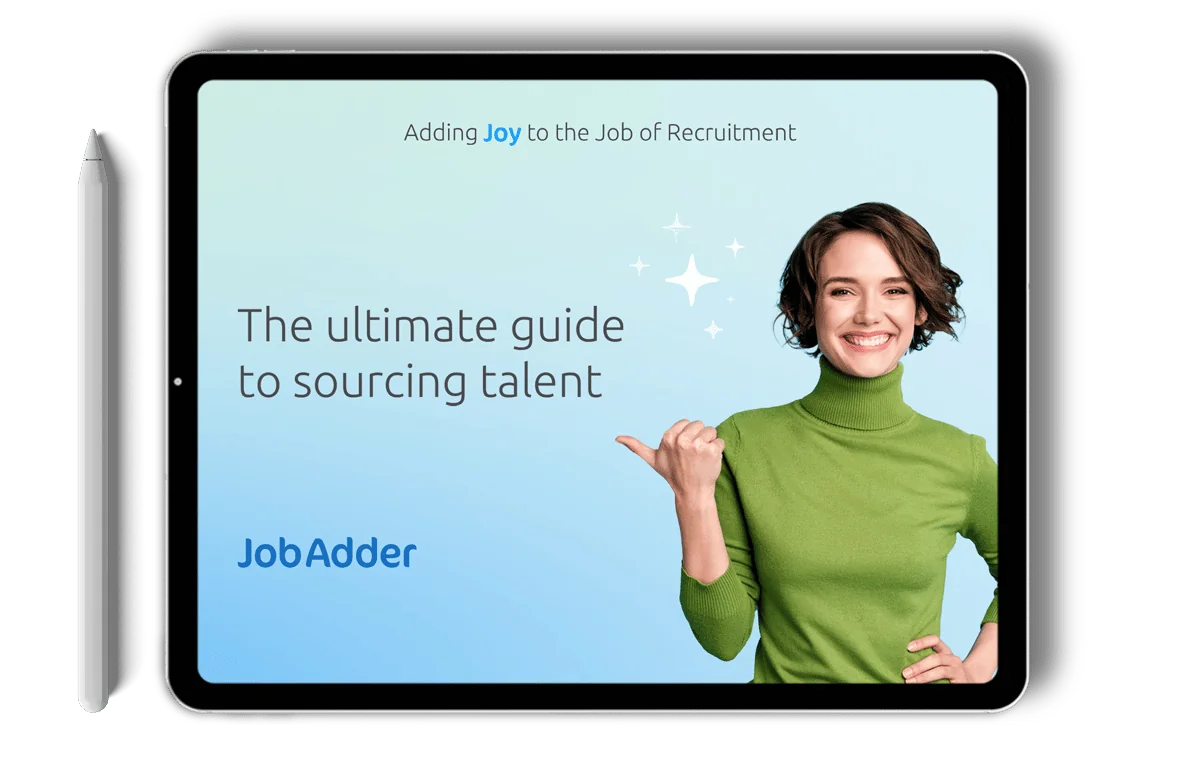Sourcing is part of the recruitment process and is therefore typically carried out by the recruitment team. However, there is a distinct difference between sourcing and recruiting.
Sourcing, also known as candidate or talent sourcing, is when the hiring department seeks out and invites potential candidates to apply for a new or future role.
Recruiting is what follows sourcing. Once a pool of the best talent is collected, recruiters review candidates and find the top talent to fill a role. Still wondering, what is sourcing in recruiting? Keep reading for a comprehensive explanation.
DOWNLOAD NOW: The ultimate guide to sourcing talent
The difference between sourcing and recruiting
While sourcing and recruiting are different, they complement one another. Sourcing paves the way for successful recruitment.
As previously mentioned, sourcing is searching for candidates, and recruiting is the phase where you review them. Keep reading for a detailed explanation of sourcing vs. recruiting.
What is sourcing?
If you’re still asking yourself what is sourcing in recruiting then no worries, we’ll delve much deeper into the concept. Sourcing candidates is the first step to a successful hire.
First, a hiring department determines the qualifications and skill sets they need, then they begin actively searching for the best candidates. This sourcing goes beyond simply posting on a job board, it’s about looking for the talent you need and proactively reaching out to them.
In these communications, your recruiters would start conversations about the open role or future open positions with qualified candidates and urge them to apply or determine their level of interest. The sole purpose of sourcing is to build a reliable talent pool of applicants that recruiters can draw from when they need talent fast.
What is recruiting?
Recruiting is a broad term that defines the entire hiring process. It includes sourcing quality candidates to build a talent pool, reviewing applicants’ resumes, conducting interviews and eventually onboarding new employees.
To complete each of the above steps with peace of mind, companies need a vast talent pool to choose from. Therefore, sourcing should be a crucial part of any recruitment strategies.
The sourcing process: How does talent sourcing work?
The recruitment team and hiring managers typically organise and execute the sourcing process. They begin by determining what their ideal candidates look like, then set out to find and network with them via social media, visit a college job fair or trade schools or browse alumni groups.
The process varies from business to business as each company has diverse needs and resources available.
Understanding talent pool vs. talent pipeline
Sourcing aims to develop a talent pool of potential candidates to fill open and future roles. Most companies already have a talent pool they refer to every time a new position opens. This group consists of previous applicants, employee referrals and organically sourced candidates.
However, successful sourcers continually add to this group by browsing LinkedIn and alumni groups or attending meetups like job fairs. However, sometimes the only information collected from these individuals is their contact information. Any candidate that’s reviewed further is part of the talent pipeline, which is a list of vetted individuals deemed qualified to fill a position the company is actively hiring for.
This smaller list may even consist of current employees fit for promotion. Together, the talent pool and talent pipeline assist the hiring department in building a network of qualified candidates for the role at hand. They also help them build a relationship with qualified candidates for a future hiring process.
The talent sourcing process
While the specifics of talent sourcing can vary from company to company, most hiring departments include four basic steps in their process, including:
- Creating a sourcing plan and strategy: This includes finding candidates that are a good fit for the company culture and current or future positions. This step may also include determining exactly where sourcers will find candidates.
- Executing the sourcing plan and strategy: Sourcers find and network with the quality candidates described in the planning process. It can look like connecting with people on social media, emailing and communicating with candidates, attending events or browsing alumni and trade school lists.
- Vetting the talent pool: Once a decently sized group of candidates is built, sourcers briefly vet the list to pinpoint which candidates they think will fit in with the company and best fulfil the duties of a specific job.
- Moving qualified candidates through the talent pipeline: Once sourcers vet their list for the best talent, they hand off their potential candidates to the people in charge of the talent pipeline—a shorter list of candidates deemed qualified to enter the hiring process.
The sourcing process ends here, and an in-depth review of each candidate begins until a decision to hire is reached. The rest of the process includes interviewing, hiring and eventually onboarding.
Sourcing strategies: Tips for effective sourcing
Crafting and executing an effective sourcing strategy can drastically improve the hiring process and company culture. Making the extra effort to actively find the right candidate will not only diminish employee turnover but improve productivity. Keep the following tips in mind to ensure your sourcing process is effective.
- Create an ideal candidate profile: Determine the education level, skill sets, job experience and attitude you desire in a candidate.
- Utilise both online and offline sourcing methods: Social networks and job boards are a great way to find candidates, but do not rely on them to tell you everything there is to know. Propose a phone chat or invite them to a networking meeting—yet another place to build your talent pool.
- Build up your employer brand: Highly-qualified candidates will not settle for a company with low morale. Practice selling and implementing an employer brand you are proud to represent.
- Improve your candidate experience: Over 80% of candidates expect the same respect as current employees. If you make a candidate feel unimportant, it’s unlikely they’ll be interested in being added to your talent pool.
- Encourage employee referrals: Who knows more about the company’s needs than current employees? Encourage employees to refer candidates they think would be a good fit by offering a reward or bonus after a successful hire.
- Develop a strong ATS: Using an Applicant Tracking System (ATS) allows you to build a diverse talent pool, keep in contact with your talent, automate manual processes, organise leads and keep track of candidates seamlessly.
- Employ the right sourcing tools: Leverage an ATS that integrates with your sourcing channels, like LinkedIn, so it can help you keep track of candidates’ information and continuously build your talent pool.
FAQ
Do you still need more information around what is sourcing in recruiting? Here are the most frequently asked questions.
What are active candidates vs. passive candidates?
An active candidate is someone applying to open positions, while a passive candidate is someone content in their current role. However, a passive candidate may express interest if your employer brand appeals to them or you offer them a better deal.
Just to recap, what is the difference between sourcing and recruiting?
Sourcing is searching for and talking to potential candidates about an open or future role. Recruiting is the reviewing of candidates and eventually hiring the best talent to fill a specific position.
How do you source candidates?
First, determine what your ideal candidate looks like. Start searching online and offline for people that meet that description. Once you find potential candidates, invite them to apply for a current position or build a relationship with them so you can add them to your talent pool for future openings.
Upgrade your sourcing strategy with JobAdder
We hope this article helped to give you more clarity on sourcing and recruitment strategies. To recap the question on what is sourcing in recruiting—sourcing is the act of searching for potential candidates to build a high-quality talent pool and it’s usually the first step in the recruiting process. It makes finding a perfect match possible but requires knowing, valuing and selling your employer brand.
JobAdder has exclusive integrations with sourcing channels, including LinkedIn and SEEK, and simplifies your entire sourcing and recruiting process. Our users can build and nurture their talent pool within our Applicant Tracking System (ATS), keeping all information and communications in one place. Find out more about how our recruitment software can simplify sourcing here.
Need help building your talent pool? Download our ultimate guide to sourcing talent.






